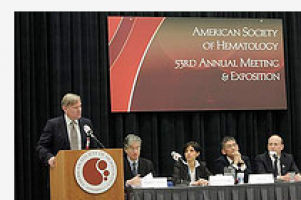
Results from a Phase III clinical trial of monoclonal antibody gemtuzumab ozogamicin (GO) find that the investigational therapy may be a promising option when used in relatively low, frequently repeated doses in conjunction with standard chemotherapy to treat older adults with acute myeloid leukemia (AML).
Chemotherapy has long been the standard of care for induction in patients with AML, an aggressive leukemia that can be fatal within weeks to months of diagnosis without proper treatment. However, with the recent development of targeted therapies, additional research has focused on improving patient outcomes while reducing toxicity associated with conventional chemotherapy regimens. Monoclonal antibodies, or MABs, attach to the cancer cell surface and, when conjugated to a toxin, release the toxin into the cell. MABs are a relatively new type of targeted therapy and are considered an enhancement to chemotherapy that allows treatment to target specific cells while reducing the toxicity to healthy cells. Because GO binds to CD33, an antigen present on AML cells, but not to normal hematopoietic stem cells, it has been the focus of recent research because of its ability to be directed specifically to AML cells.
To evaluate the efficacy of GO when used with chemotherapy in older AML patients, a team of researchers with the Acute Leukemia French Association designed a Phase III, prospective, open-label, randomized trial. Primary study endpoints focused on event-free survival (EFS); secondary endpoints included response rate, disease-free survival (DFS), overall survival (OS), and safety over a three-year follow-up period. Study participants (adults age 50-70 with previously untreated de novo, or first occurrence of, AML) were randomized into one of two treatment arms – either standard chemotherapy referred to as DA, (daunorubicin, ara-C, n=134) or chemotherapy with the addition of GO (DAGO, n=137).
The study demonstrated that adding GO to a standard chemotherapy regimen significantly improved EFS and OS in older adult AML patients. At two years of follow-up, the rate of EFS was estimated at 15.6 percent in the DA arm compared with 41.4 percent in the DAGO arm. DFS was estimated at 18.1 percent in the DA arm versus 48.5 percent in the DAGO arm. The benefit in EFS was observed in all age groups and translated into a longer OS (19 months vs. 34 months on average in DA arm vs. DAGO arm).
The treatment protocol had some toxicity, as the rate of fatal adverse events possibly attributable to treatment was 6.7 percent in the DA group and 8.7 percent in the DAGO group. Prolonged grade 3 or greater thrombocytopenia was observed in 19 DAGO patients, and three episodes of veno-occlusive disease or sinusoidal obstructive syndrome (liver vein blockages) were observed in the DAGO arm, two noted as fatal. There were no differences between the arms in the incidence of severe sepsis or in the rate of intensive care unit admission during the course of therapy.
“Research has demonstrated that GO has very potent anti-cancer properties, and with this study we have identified a dosing regimen that gives patients the therapeutic benefit without some of the toxicities previously reported at higher doses,” said lead author Sylvie Castaigne, MD, Professor in the Department of Hematology at Hôpital de Versailles in Versailles, France. “Specialists treating AML have not been offered a new therapeutic option for several decades, and with this research we are encouraged that GO may be able to deliver better overall outcomes for these AML patients with limited alternatives.”
Source: ASH
We are an independent charity and are not backed by a large company or society. We raise every penny ourselves to improve the standards of cancer care through education. You can help us continue our work to address inequalities in cancer care by making a donation.
Any donation, however small, contributes directly towards the costs of creating and sharing free oncology education.
Together we can get better outcomes for patients by tackling global inequalities in access to the results of cancer research.
Thank you for your support.